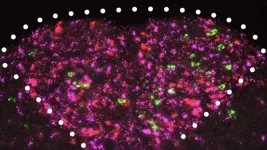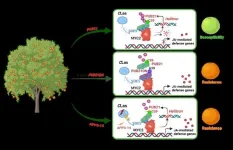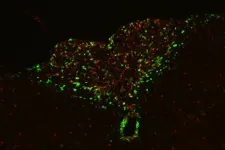(Press-News.org) Hoboken, N.J., April 10, 2025 — If you eat a snack — a meatball, say, or a marshmallow — how will it affect your blood sugar? It’s a surprisingly tricky question: the body’s glycemic response to different foods varies based on individual genetics, microbiomes, hormonal fluctuations, and more. Because of that, providing personalized nutritional advice — which can help manage diabetes, obesity, and cardiovascular diseases, among other conditions — requires costly and intrusive testing, making it hard to deliver effective care at scale.
In a paper in the Journal of Diabetes Science and Technology, researchers at Stevens Institute of Technology offer a new approach: a data-sparse model capable of accurately predicting individual glycemic responses with no need for blood draws, stool samples, or other unpleasant testing. The key to their approach? Keeping track of what people actually eat.
“It might sound obvious, but until now most research has focused on macronutrients, such as grams of carbohydrates, instead of the specific foods that people are eating,” explains Dr. Samantha Kleinberg, Farber Chair Professor of Computer Science. “We’ve shown that by analyzing food types, it’s possible to make highly accurate predictions with far less data.”
Dr. Kleinberg’s team studied two datasets that include both detailed food diaries and continuous glucose monitor data for almost 500 people with diabetes (both types 1 and 2) based in the United States and China. Using existing food databases and ChatGPT, they classified each meal according to macronutrient content and also leveraged the structure of foods (so meats are more similar to each other than to cheeses), enabling them to differentiate between nutritionally equivalent foods.
By training an algorithm using both nutritional data and food features, plus a few demographic details, the team was able to predict each individual’s glycemic response to each food with virtually the same levels of accuracy found in prior studies that included detailed microbiome data and other hard-to-collect information.
“We still don’t know why including the food features makes such a big difference,” Dr. Kleinberg says. It’s possible that food information is a proxy for micronutrients that drive glycemic responses, or that the physical properties of certain foods lead people to eat or digest them differently. “What’s clear, though, is that when it comes to blood sugar, there’s more at work than just macronutrients,” Dr. Kleinberg says.
By focusing on food types, the team was also able to explore individual variations in glycemic responses. “Because people eat the same meals again and again, the data gives us visibility into the way that individual responses to specific foods change over time,” Dr. Kleinberg explains. The team found that including data about menstrual cycles in their model accounted for much of the intra-subject variation, suggesting that shifting hormone levels could play an important role in mediating individual glycemic responses.
The team’s model also accurately predicts glycemic response for both U.S. and Chinese populations — an important finding, since microbiome-based models often struggled to deliver accurate results across different cultural contexts. “We don’t need data on a specific regional population to be able to make predictions there,” Dr. Kleinberg explains.
The new model is also powerful enough to predict an individual’s glycemic responses based on demographic data, without customized training on food logs or other personalized data. As a result, clinicians could potentially use the model to offer nutritional advice during an initial meeting with a patient, without the need for laborious food logging or intrusive testing. “We can offer better recommendations if we have more data, but we can get very good results with no personalized information at all,” Dr. Kleinberg explains. “That means we can give patients useful advice right away — and hopefully that will motivate them to keep going.”
Next, the team plans to refine their model using larger datasets, and to explore whether adding microbiome data increases their model’s accuracy. “That’s the big question, because if food information alone gives us everything we need, there might be no need to collect stool samples or do other tests,” Dr. Kleinberg says. “That could make personalized nutrition more affordable and accessible for everyone.”
END
Stevens researchers put glycemic response modeling on a data diet
Data-sparse method opens door to personalized nutrition—without the stool samples
2025-04-10
ELSE PRESS RELEASES FROM THIS DATE:
Genotype-to-phenotype map of human pelvis illuminates evolutionary tradeoffs between walking and childbirth
2025-04-10
A combined study on the morphology of the human pelvis – leveraging genetics and deep learning on data from more than 31,000 individuals – reveals genetic links between pelvic structure and function, locomotion, and childbirth outcomes, researchers report. The findings offer fresh insights into how our species evolved to balance the competing demands of bipedalism and childbirth. The transition to bipedalism in hominins led to significant changes in pelvic morphology, including a shorter and wider pelvis, which facilitated an upright posture and efficient locomotion. However, ...
Pleistocene-age Denisovan male identified in Taiwan
2025-04-10
A fossil Pleistocene-age hominin jawbone discovered in Taiwan has now been identified as belonging to a Denisovan, according to a new paleoproteomic analysis of the remains. The findings provide direct molecular evidence that Denisovans occupied diverse climates, from the cold Siberian mountains to the warm, humid subtropical latitudes of Taiwan, and offer new morphological insights into this enigmatic hominin lineage. Recent research has revealed a surprising variety of ancient human relatives that lived in eastern Asia during the Pleistocene before modern humans arrived. One of the most important discoveries is the Denisovans, a distinct group identified through DNA ...
KATRIN experiment sets most precise upper limit on neutrino mass: 0.45 eV
2025-04-10
Researchers from the KATRIN (Karlsruhe Tritium Neutrino) experiment report the most precise measurement of the upper mass limit of the neutrino to date, establishing it as 0.45 electron volts (eV) – less than one-millionth the mass of an electron. The findings tighten the constraints on one of the universe’s most elusive fundamental particles and push the boundaries of physics beyond the Standard Model. Neutrinos – electrically neutral elementary particles – are the most abundant particles in the universe and ...
How the cerebellum controls tongue movements to grab food
2025-04-10
By studying the skilled movements of marmoset tongues, researchers have discovered that Purkinje cells (P-cells) in a brain region called the cerebellum signal to stop protrusion as the tongue approaches its target, according to a study published April 10th in the open-access journal PLOS Biology by Reza Shadmehr from Johns Hopkins School of Medicine, U.S., and colleagues.
We use our tongue to shape the air and generate sounds to communicate, and we use our tongue to evaluate food morsels and transport them through the oral cavity when eating. These skillful acts involve coordination of more ...
It’s not you—it’s cancer
2025-04-10
Cancer ravages both body and mind. If you’ve ever lost loved ones to the disease, you might recognize the physical and emotional changes cancer patients often endure during their final months. They seem drained of strength and spirit. Even people who’ve maintained a positive outlook throughout their lives can enter a state of despair. New research published in Science suggests apathy and lack of motivation are symptoms of a condition called cancer cachexia. Cold Spring Harbor Laboratory ...
Drug pollution alters migration behavior in salmon
2025-04-10
In the largest study of its kind to date, a team of international researchers has investigated how pharmaceutical pollution affects the behaviour and migration of Atlantic salmon.
The study, led by the Swedish University of Agricultural Sciences, revealed that commonly detected environmental levels of clobazam – a medication often prescribed for sleep disorders – increased the river-to-sea migration success of juvenile salmon in the wild.
The researchers also discovered that clobazam shortened the time it took for juvenile salmon to navigate through two hydropower dams along their migration route – obstacles that typically ...
Scientists decode citrus greening resistance and develop AI-assisted treatment
2025-04-10
In a groundbreaking study published in Science, a research team led by Prof. YE Jian from the Institute of Microbiology of the Chinese Academy of Sciences has identified the first mechanism of citrus resistance to citrus greening disease, or huanglongbing (HLB).
Utilizing artificial intelligence (AI), the team has also developed antimicrobial peptides that offer a promising therapeutic approach to combat the disease. This discovery addresses a long-standing challenge in the agricultural community—the absence of naturally occurring HLB-resistant genes in citrus.
Citrus ...
Venom characteristics of a deadly snake can be predicted from local climate
2025-04-10
Local climate can be used to predict the venom characteristics of a deadly snake that is widespread in India, helping clinicians to provide targeted therapies for snake bite victims, according to a study publishing April 10 in the open-access journal PLOS Neglected Tropical Diseases by Kartik Sunagar and colleagues at the Indian Institute of Science.
Russell’s viper (Daboia russelii) is found across the Indian subcontinent and is responsible for over 40% of snake ...
Brain pathway links inflammation to loss of motivation, energy in advanced cancer
2025-04-10
The fatigue and lack of motivation that many cancer patients experience near the end of life have been seen as the unavoidable consequences of their declining physical health and extreme weight loss. But new research from Washington University School of Medicine in St. Louis challenges that long-held assumption, showing instead that these behavioral changes stem from specific inflammation-sensing neurons in the brain.
In a study published April 11 in Science, the researchers report that they identified a direct connection between cancer-related inflammation ...
Researchers discover large dormant virus can be reactivated in model green alga
2025-04-10
Researchers had been studying the green alga Chlamydomonas reinhardtii for decades without seeing evidence of an active virus within it — until a pair of Virginia Tech researchers waded into the conversation.
Maria Paula Erazo-Garcia and Frank Aylward not only found a virus in the alga but discovered the largest one ever recorded with a latent infection cycle, meaning it goes dormant in the host before being reactivated to cause disease.
“We’ve known about latent infections for a long time,” said Aylward, associate professor in the Department of Biological Sciences. ...
LAST 30 PRESS RELEASES:
How cells balance their protein levels
Nirsevimab vs RSVpreF vaccine for RSV–related hospitalization in newborns
Effectiveness and impact of maternal RSV immunization and nirsevimab on medically attended RSV in US children
AI gives scientists a boost, but at the cost of too many mediocre papers
Next-generation vision model maps tree growth at sub-meter precision
Genes aren’t destiny for inherited blindness, study shows
MIT study: High-fat diets make liver cells more likely to become cancerous
Exposure to multiple fine particulate matter components and incident depression in the US Medicare population
Risk of burdensome health care spending over time in the US
Nirsevimab against hospitalizations and emergency department visits for lower respiratory tract infection in infants
New microfluidics technology enables highly uniform DNA condensate formation
A new strategy for immune tolerance
Super Mario Bros. help fight burnout: New study links classic games to boosted happiness
Deepest gas hydrate cold seep ever discovered in the arctic: International research team unveils Freya Hydrate Mounds at 3,640 m depth.
Integrating light and structure: Smarter mapping for fragile wetland ecosystems
ACA-SIM: A robust way to decode satellite signals over complex waters
Probiotics can restore gut microbiome in breastfed infants
AI could help predict nutrition risks in ICU patients, study finds
Federal EITC has unexpected result, researchers say – it decreases domestic violence
Researchers identify gene that calms the mind and improves attention in mice
Artificial metabolism turns waste CO2 into useful chemicals
Ancient sea anemone sheds light on animal cell type evolution
Begging gene leads to drone food
How climate policies that incentivize and penalize can drive the clean energy transition
Can community awareness campaigns in low-resource areas improve early diagnosis of colorectal cancer?
Stardust study resets how life’s atoms spread through space
Practical education: Clinical scenario-based program development
The impact of family dynamics on eating behaviour – how going home for Christmas can change how you eat
Tracing the quick synthesis of an industrially important catalyst
New software sheds light on cancer’s hidden genetic networks
[Press-News.org] Stevens researchers put glycemic response modeling on a data dietData-sparse method opens door to personalized nutrition—without the stool samples





